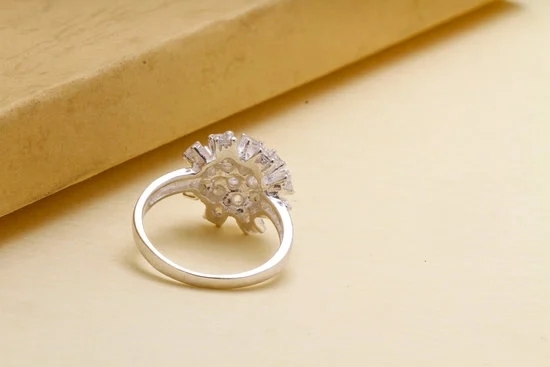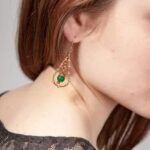Art Deco jewelry is a type of jewelry style characterized by its geometric shapes, bold colors, and stylish, yet delicate designs. It emerged during the first half of the 20th century and was inspired by abstract art movements such as Cubism and Futurism.
Art Deco jewelry typically includes precious gems and metals such as gold, platinum and diamonds. This type of jewelry has a certain aesthetic value and often celebrates a particular moment in history that is meaningful to the wearer or collector.
Today, Art Deco jewelry holds high market value due to its age, design quality, and rarity. The 1920s were among one of the most iconic decades for Art Deco style and many pieces from this era are highly sought after today; often at higher prices than contemporary pieces.
One reason why Art Deco jewelry holds so much value is because it represents status; having a piece of fine art on your finger coupled with the reputation behind it makes art deco jewels very desirable assets. Additionally, those with rarer designs and precious metals tend to fetch higher prices due to their small availability in today’s market.
How to Assess an Art Deco Jewelry Piece
The first thing to do when assessing an art deco jewelry piece for value is to examine its condition closely. Details like craftsmanship should be taken into account; if there are any damages or signs of wear-and-tear, it will affect its overall value significantly.
If there are repairs necessary or original stones missing that cannot be replaced, it may make finding a buyer more difficult since restoration isn’t exactly recommended for vintage items like this unlike newer pieces with modern technology available for repair work or replacements.
Next, investigate the metallic content found in a piece of art deco jewelry – 18 carats gold being common within most vintage rings but they can contain anywhere between nine and 24 carats too. It’s important to know what percentage of gold was used within a piece as this can affect its price quite substantially alongside other metals like silver or platinum which have different levels pricing points than pure gold similar grade pieces would have.
Also consider authenticity – authentic jewels come with hallmarks that reflect country origin such as ‘750’ indicating Italy production – these factors must also be brought up prior deciding on value due to varying pricing brackets each trademark stands for globally.
Historical Context
Art Deco jewelry has become highly sought after by collectors and those who recognize its breathtaking beauty. This era of design emerged between the two wars, World War I (1914-1918) and World War II (1939-1945). It eventually spanned from 1919 to 1939 and gained its name from the 1925 Exposition Internationale des Artis Decoratifs et Industriels Modernes in Paris.
During this period, a wide range of material was used in modernist designs, such as colored gemstones, diamonds, Bakelite, glass, ivory, metal alloys like silver and gold, synthetic rubies and sapphires. Many pieces also show enameled details or other decorations like cabochon cut stones or filigree setting. Fine examples of this type of rare design are found among items created by famous names such as Cartier, Line Vautrin, Boucheron and Castillo.
One highly notable example of historical Art Deco jewelry is the Maharajah Emerald emerald necklace designed by Cartier in 1931 for The Maharaja of Patiala India. This dazzling piece was an amalgamation of six oval Kashmiri emerald drops topped with diamond clusters in platinum settings surrounded by a further 220 carats worth of diamonds along the lengthy necklace chain giving it a total length of nearly four feet.
Since then it has been auctioned off twice; the first time during 1997 where it set a record breaking sale price at Sotheby’s London and again when it made more than $7 Million USD at a Christie’s New York auction 2015.
A second impressive example specifically in regard to design is Vever’s 1926 Double Dragon cuff bracelet commissioned by Dr Georges Fouquet. Made up with gold featuring turquoise double dragon heads designs meshed within silver frames interlayered ontop ruby eye mounts and finely shaped scalloped edges along the circumference completed with tiny glimmering diamonds around them.
This quality piece is said to have greatly inspired other strikingly similar creations that followed such as line Vautrin 1951 Piece “Doubles Dragons”. All these exquisite pieces showcase renowned techniques considered hallmark’s which define authentic Art Deco jewelry contemporary to their era and often continue to influence modern day artists today.
Materials Used
The value of art deco jewelry is largely based on the materials used in its creation, as well as its age and design. Depending on the type of metal, gemstones or other materials found in a piece of art deco jewelry, the value may vary significantly. Popular metals used to create art deco jewelry are gold, silver, bronze and titanium.
These metals are especially sought after when crafted in the form of geometric shapes typically associated with this design style. The grade or quality of these metals is also important; higher quality will mean a higher valued piece of jewelry.
Gemstones were commonly used during the Art Deco period to give pieces additional flare. Each stone can add unique characteristics which drives up their worth. Precious stones such as diamonds and sapphires are highly desirable because of their beauty and rarity.
Other semi-precious stones like jade, coral or turquoise offer vibrant color variations to attract buyers, while pearls give pieces an added softness. Even though they generally cost less than precious gems, adding any kind of stone will generally increase a piece’s overall value.
Fewer materials that are usually seen in modern day jewelry production techniques are also present in some pieces from this era – glass is particularly plentiful as it was much easier to work with than many harder materials available at the time. Designer’s often employed glass as an inset on cutout pieces or even entire brooches that relied heavily on shape layered shielding for light dispersion effects depending on the faceted design put forth by the artisan who created it.
When these delicate details remain intact its impact upon increasing an individual piece likeness is considerable pushing prices up wards accordingly.
In conclusion, when determining a value for art deco jewelry one must consider all elements including but not limited to: material used (i.e., precious/semi-precious metals/gems), age/condition/purity and design characteristics at play (i.e., shape/cutouts/insets).
In summation, intangible qualities such as how long a piece has been crafted over time can impact market demand which ultimately affects its price point accordingly – therefore making it well worthwhile engaging experienced professionals whenever dealing with rare antiques of that nature.
Designs of Art Deco Jewelry and Its Impact on Value
Art Deco jewelry is highly desired as a collectible and has grown in value for many years. The designs are popular because of their bold look and elegantly crafted details that draw the eye.
Created in the 1920s and 1930s, Art Deco jewelry was heavily influenced by the emerging modern movement of the time. This move toward modernism helped give Art Deco its iconic geometrical influence, with colored gemstones often taking center stage such as rubies, sapphires, onyx, platinum, gold studded with diamonds, emeralds or pearls.
Designers of Art Deco jewelry tended to favor organic symmetry rather than perfect symmetry when creating pieces. Thus this added a level of authenticity to each piece, making it almost one-of-a-kind.
This can also have an impact on a piece’s value as unique pieces become more sought after over those that have been replicated multiple times. This uniqueness keeps collectors interested in Art Deco styles as every piece tells a story through its unique design elements and materials used.
The quality of craftsmanship within Art Deco pieces can also add to their worthiness over time due to many metals or gems being intricately handcrafted and precisely cut for a specifically designed piece. Quality stones can take a piece into an expert grading system which is especially valuable for certain pieces made before 1940 when gemstone treatments were less common than they are today so these untreated gems when they come with certificates can push up the value significantly too.
All these factors contribute to increased desirability in collectible art deco jewelry with demand still increasing year after year; this helps retain the high value that it holds despite being created almost a century ago.
Value of Art Deco Jewelry During Different Eras
The value of Art Deco jewelry has been a point of discussion for many years. This is especially so since the stunning designs and craftsmanship have become associated with luxury and exclusivity. Currently, the acclaimed modern-era pieces generally have high market values due to their intricate beauty, limited availability, and the mark of famous names in jewelry design. But what about during different eras? Has anything changed or altered the value of Art Deco jewelry over time?
When Art Deco first emerged around 1917, it was an era marked by bright colors, geometric shapes and sharp lines. The geometric style of Art Deco jewelry allowed jewelers to create truly unique pieces that were both beautiful as well as easily affordable.
During this time, its influence was felt throughout society and spanned across it mixing elements from cubism, futurism, modernism amongst a host of other influences. As such, its value at this stage in its emergence was lower than we see today however due to its wide popularity some pieces were made in higher end metals such as silver or gold which were then embellished with gems like emeralds or diamonds which increased their value significantly.
As time progressed into the Great Depression era (1929 – mid 1930s) economic instability meant that income decreased drastically for all sectors making purchasing jewelry much more difficult for consumers. This decline in demand caused a subsequent decrease in value when it came to pricing Art Deco pieces resulting in fewer sales for jewelers having had to resort to slashing prices in order to make any money off their creations at all.
That said by mid-decade things had stabilized somewhat with improved living standards increasing demand again slowly but surely causing a rise in prices albeit very slight increases compared to pre-Depression times.
This situation remained consistent until WW2 ignited where resources were put towards war effort instead meaning values stayed low till peaking during 1948 before gradually trending back down again during the 1950s postwar era only to be revived in the later sixties when the revival movement began with renewed love for art deco aesthetics inspiring people all over again leading gem sets becoming desirable soon enough too thus marking an increase back up on overall pricepoints ranging from costume pieces accessible none wiser up till genuine art deco antiques bringing out collectors who bid sums into tens thousands for rare specimens ready to add them into household collections enlivening old days glamour still exhibited timelessly treasure sized.
Factors That Determine the Value of Art Deco Jewelry
The art deco style of jewelry is a timeless symbol of elegance and beauty. As such, it has remained highly sought-after for centuries, which means that its value can fluctuate based on several factors. Collectors are always looking for the rarest and most eye-catching pieces, so their opinion as to what is valuable matters significantly when it comes to determining its true worth.
Similarly, jewelry trends also have a big impact – certain colors or shapes may be more desirable than others at any given moment in time. And of course, the age and condition of an item are two key determine values as well; older pieces tend to attract the highest premiums.
While there is certainly no foolproof formula when it comes to assigning value to this type of jewelry, there are certain features that collectors look out for in order to ascertain its worth. The materials used in constructing an art deco piece can often give us a good indication; items featuring metals such as platinum and gold will naturally cost more.
Likewise, stones like diamonds and rubies are both highly prized within the art deco circle, although other semi-precious stones such as sapphires and emeralds can also add considerable value depending on their cut and rarity.
The signature styles associated with art deco jewellery can be expected to dampen prices further; geometric shapes like rectangles and circles appeal greatly among lovers of this unusually shaped genre, with smooth flowing lines embracing all else from subtle curves through dragonfly decorations to bold chevrons or Egyptian motifs.
Unusual settings like baguettes or star designs may also interest potential buyers due to their decorative nature combined with functionality – indeed these pieces will likely demand higher valuations than the rest due to their singular design heritage.
Cleaning and Caring for Your Art Deco Jewelry
The value of Art Deco jewelry is timeless-from a monetary standpoint, that is. As with any classic or vintage piece (especially those made of precious metals and gemstones or those with intricate details), it’s important to take the proper measures to ensure you preserve its value and worth. Here we examine some tips for properly cleaning and caring for your Art Deco jewelry.
When it comes to cleaning, most experts recommend using a soft polishing cloth for occasional wiping and light cleanings. Be sure to avoid harsh scrubs as much as possible as these can damage the metal or gems used on the jewelry pieces. For more serious tarnishing, use a mild solution soap and warm water instead. If unsure about the type of product you are supposed to use, contact a professional jeweler for advice prior to cleaning.
One mistake often made when caring for antique pieces like those from the Art Deco era is wearing them too often. Every time you wear your jewelry-regardless of whether it’s a ring, pendant, bracelet or earrings-dirt quickly builds up on it which increases its likelihood of developing scratches or other signs of wear over time.
This can significantly reduce its value so it’s best to avoid wearing your pieces during everyday activities like gardening or housekeeping chores in order to protect them from potential damage.
In addition to limiting how often you wear each piece, be sure not to leave them loose on surfaces inside drawers or tables where they could easily scratch against something else and get damaged in the process. Instead, opt for smooth padded boxes specifically designed for storing jewelry items in an orderly fashion and safe space away from dust particles that could cause corrosion if left unchecked over time.
Finally, consider taking out protection insurance policies for especially valuable pieces in order to guarantee their protection should any unforeseen events present themselves down the road.
Conclusion
Insuring your Art Deco jewelry is a crucial step in protecting its value. Most insurance companies will appraise the jewelry and assign it a monetary value before they agree to provide coverage. This ensures that you can receive full compensation if any harm comes to the jewelry, or in case of theft. In addition, special restrictions may apply for certain rare items, so be sure to ask your insurer about appropriate procedures for these pieces of jewelry.
Knowing how to spot telltale signs of authenticity for Art Deco jewelry can be another way to help you discern the true value of an item. These pieces often feature enameling or bold use of color patterns and geometric shapes. Some common symbols used during this time period include the chevron designs and sunbursts from ancient sun worship religions.
Not all pieces will display these characteristics, as they were designed during a lax period with no official rules prohibiting self-expression through design. Therefore, some pieces may not have any particular hallmark associated with them, making it difficult to determine their exact age and origin.
Finally, collectors look for ways to increase the value of their Art Deco jewels by purchasing them at auctions or estate sales. These outlets often possess rarer pieces that are kept away from public view and offered at significantly discounted prices compared to those seen in retail stores or galleries.
However, due diligence is essential whenever attempting to acquire antique items, as sellers need accurate records corroborating the origin and condition of each piece in order for it to maintain its original resale price. Additionally, proper packaging and storage are necessary components when aiming to preserve original quality over long periods of time; oxidation especially has been known fade finishes on many older items faster than expected without periodic maintenance treatments.

Welcome to my jewelry blog! My name is Sarah and I am the owner of this blog.
I love making jewelry and sharing my creations with others.
So whether you’re someone who loves wearing jewelry yourself or simply enjoys learning about it, be sure to check out my blog for insightful posts on everything related to this exciting topic!





